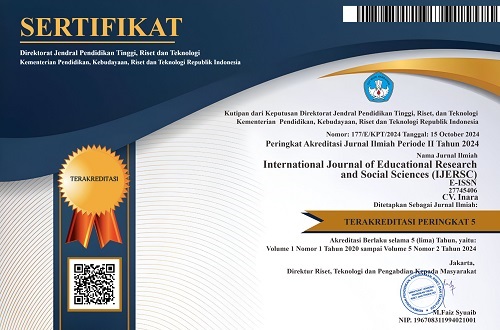Japanese Comic Strips in Increasing Writing Learning Achievement
DOI:
https://doi.org/10.51601/ijersc.v5i4.859Abstract
The purpose of this study was to determine the effect of using Japanese comic strip media on students' writing skills. This study used a quasi-experimental method with a one-group pretest and posttest experimental design. The study was conducted in two classes (60 students) who received writing courses in the even semester of the 2023-2024 academic year. The data collection process used documents, observations and tests. The data analysis technique used a two-sample paired t-test. The test results showed t-stat <t-table (-49.4457 <2.0009), meaning that the use of Japanese comic strip media had a significant effect on students' Japanese writing skills. The pre-test results concluded that the high error rate was in the aspects of organization, logical development of ideas and grammar. However, the post-test results showed that the error rate was very small and below 30%. The results of the study have implications for the development of comic strip media as a tool for learning to write Japanese and students have also become familiar with Japanese culture from stories in comics
Downloads
References
N. Aini, N. Aini, And R. N. Indah, “Manga Is Our World: The Use Of Manga As Media In Teaching Writing Recount Text,” English Education: Jurnal Tadris Bahasa Inggris, Vol. 16, No. 2, Pp. 285–303, Dec. 2023, Doi: 10.24042/Ee-Jtbi.V16i2.18162.
F. Ahsanah And D. T. P. Utomo, “The Use Of Digital Comic In Developing Student’s English Competence,” Ideas: Journal On English Language Teaching And Learning, Linguistics And Literature, Vol. 8, No. 2, Pp. 373–383, Dec. 2020, Doi: 10.24256/Ideas.V8i2.1660.
F. Fernando And D. Aminatun, “Students’ Perspective Toward The Use Of Digital Comic In Learning Writing Skill,” Journal Of English Language Teaching And Learning, Vol. 2, No. 2, Pp. 90–94, Dec. 2021, Doi: 10.33365/Jeltl.V2i2.1157.
R. G. Anggraeni, M. Martono, And A. D. Rais, “Improving Students’ Writing Skill By Using Comic Strips,” English Education, Vol. 4, No. 1, P. 1, Sep. 2015, Doi: 10.20961/Eed.V4i1.34615.
Zulhasmi Abasa, Z. Hamdani, Darwanto, And B. Husain, “The Student’s Responses To The Use Of Comic Strips As A Learning Media,” Journal Of English Education And Linguistics, Vol. 3, No. 1, Pp. 95–101, Jun. 2022, Doi: 10.56874/Jeel.V3i1.805.
E. A. Wijaya, N. K. A. Suwastini, N. L. P. S. Adnyani, And K. E. K. Adnyani, “Comic Strips For Language Teaching: The Benefits And Challenges According To Recent Research,” Eternal (English, Teaching, Learning, And Research Journal), Vol. 7, No. 1, P. 230, Jun. 2021, Doi: 10.24252/Eternal.V71.2021.A16.
S. Rahayu, “The Effectines Of Comic Strips And Text In Teaching Narrative To Improve Students’ Reading Comprehension,” Secondary: Jurnal Inovasi Pendidikan Menengah, Vol. 3, No. 1, Pp. 54–63, Mar. 2023, Doi: 10.51878/Secondary.V3i1.1972.
F. Iswari, “Delivering Messages Through Comic Strip As Learning Media: An Analysis Of Message Forms,” Journal Of English Language Teaching And Literature (Jeltl), Vol. 4, No. 1, Pp. 46–57, Feb. 2021, Doi: 10.47080/Jeltl.V4i1.1221.
N. Fitriyanti, B. S. Bahri, And A. Kristanto, “Comics As Instructional Media In Education Journals Across Indonesia: A Systematic Literature Review,” Jurnal Teknologi Pendidikan : Jurnal Penelitian Dan Pengembangan Pembelajaran, Vol. 8, No. 1, P. 84, Jan. 2023, Doi: 10.33394/Jtp.V8i1.6059.
D. Kusrini, V. L. Dewanty, A. Putri, And R. A. Putri, “Development Of Comic Books As Teaching Media For Japanese Language Learners In Indonesian High Schools,” Proceedings Of The Fifth International Conference On Language, Literature, Culture, And Education (Icollite 2021), Vol. 595, Jul. 2022, Doi: 10.2991/Assehr.K.211119.031.
A. Amrizal, “The Effect Of Comic Strip As Instructional Method In Enhancing Students’ Writing Skills,” Journal Of Education And Teaching (Jet), Vol. 3, No. 2, Pp. 195–202, Jul. 2022, Doi: 10.51454/Jet.V3i2.182.
J. W. Creswell And J. D. Creswell, Research Design: Qualitative, Quantitative, And Mixed Methods Approaches Fifth Edition. New York: Sage Publications Inc., 2018.
S. C. Weigle, “Second Language Writing Assessment,” Handbook Of Second And Foreign Language Writing, Pp. 473–493, 2016, Doi: 10.1515/9781614511335-025/Html.
D. Brown, Language Assessment: Principles And Classroom Practices. San Francisco: Pearson Education, 2004.
N. 1957- Tsankarē, J. Banerjee, K. 1946- Knapp, G. 1949- Antos, And D. 1961- Perrin, “Handbook Of Second Language Assessment,” 2016.
S. A.- Calisto Miranda, G. M. Ulloa -Salazar, C. H. Díaz -Larenas, S. A.- Calisto Miranda, G. M. Ulloa -Salazar, And C. H. Díaz -Larenas, “Comic-Based Instruction And Vocabulary Learning Among 11th And 12th Graders In Two Chilean Schools,” Intersedes, Vol. 19, No. 39, Pp. 78–104, Jul. 2018, Doi: 10.15517/Isucr.V19i39.34071.
N. Rohmaniah And M. Mustofa, “Improving Students’ Skills In Writing Narrative Text By Implementing Comic Strips Media At Ma. Riyadlus Sholihin,” Edutec : Journal Of Education And Technology, Vol. 6, No. 4, Pp. 526–542, Jun. 2023, Doi: 10.29062/Edu.V6i4.465.
R. N. Selong, S. T. Olii, And A. Rettob, “Students’ Perception On The Use Of Comic Strips In Creative Writing,” Journal Of English Language And Literature Teaching, Vol. 5, No. 2, Feb. 2021, Doi: 10.36412/Jellt.V5i2.2458.
D. Rakhmawati, “The Effectiveness Of English Comic In Teaching Grammar (Present And Past Tense),” Jurnal Smart, Vol. 4, No. 1, Feb. 2018, Doi: 10.26638/Js.599.203x.
F. Martages, B. Suharjito, And A. Santihastuti, “The Effect Of Using Comic Strips On The Eighth Grade Students’ Narative Writing Achievement At Smp Negeri 5 Jember,” Jurnal Edukasi, Vol. 4, No. 2, P. 1, Aug. 2017, Doi: 10.19184/Jukasi.V4i2.5201.
Downloads
Published
How to Cite
Issue
Section
License
Copyright (c) 2024 International Journal of Educational Research & Social Sciences

This work is licensed under a Creative Commons Attribution 4.0 International License.






















